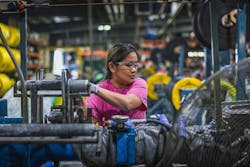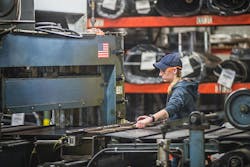Eliminating Gender Bias at WCCO Belting
Sometimes strategies work out even better than planned.
WCCO Belting, a manufacturer of custom rubber belting for machines serving the agriculture, construction, industrial, and recycling industries based in Fargo, N.D, wanted to ensure that its business culture expanded at the same rate as its business volume.
“One of the cores of our culture is respect,” explains Jean Voorhees, vice president of Business Development. “Every employee understands that from the minute they walk in the door.”
When the company wanted to expand the role of women in its workforce they viewed this goal from the perspective of respect and so focused on ability and not gender.
“To attract more women, especially in a tight labor market, we adopted a strategy of driving gender bias out of our company,” said Voorhees.
And that strategy worked. Women comprise almost half of the production floor jobs and 45% of the management jobs.
How did this happen?
First, let’s go back to when Ed Shorma founded the company in 1953. His story is best explained by President Regan's comments when he presented Shorma with the 1982 Small Business Person of the Year.
“Edward Shorma, a Korean War Veteran, mortgaged the family car and borrowed $1,500 in 1953 to buy a shoe repair shop in North Dakota. During his first year of operation, he grossed $5,400. Today, he has expanded it into a multi-million-dollar business providing jobs for hundreds of people.”
Ed's path to success reflected his ability to spot trends and adapt. He moved from repairing shoes to repairing farm truck seats and tarps when the need arose and created the Wahpeton Canvas Company (WCCO). After a shortage of cotton in the 1980s, he repurposed heat-sealing equipment from the kitchen cabinet industry into a rubber vulcanization press. That process led to the company engineering rubber products for a growing list of domestic and international equipment manufacturers and distributors.
Adapting to changing market needs has been the key to growth for this company so it would only follow that the company would adapt to the changing labor force.
And one of the largest trends in manufacturing over the past couple of decades is bringing women into the field. The company uses a task force of 20 people from every part of the business to discuss company policies. "When discussing who can perform a job the question isn't whether a woman can do the job but instead who can do a job, regardless of gender," Voorhees said.
Another tool to minimize gender bias is creating a more collaborative environment. Using a kaizen-type of process, in 2014 the company asked employees for improvements. The 1000 improvements that were made based on these suggestions had nothing to do with who made the suggestions. If women were concerned about their voices being heard in manufacturing companies, which can be an issue according to Voorhees, WCCO heard them loud and clear.
Another issue that many women have about working in manufacturing is rotating work schedules. Schedules often change based on production demands. But WCCO chose another route. “We found that by using a known schedule, it would be easier for women to be able to plan around the demands on their personal lives,” said Voorhees.
Concern for employees’ personal lives is reflected in the company wellness initiative. Comprised of five pillars – Career, Community, Physical, Financial and Spiritual—the goal is to help employees deal with issues outside of the work environment. For example, if a single parent is trying to make ends meet the company offers advice on how to find community resources or how to use financial tools such as a 401K to achieve goals. Voorhees said that many women have been volunteering to be on the wellness committee.
In addition to personal support, business support comes in the form of training. Women are often new to the field and the company recognizes this and wants them to be as comfortable as possible. They offer 50 training courses on manufacturing techniques, company operations and even emotional intelligence.
“To us, emotional intelligence is teaching people how to work with their colleagues by understanding that everyone comes to a job with different ideas and abilities,” says Voorhees. “We want employees to strive to figure out ways to work with each other.” In fact, the company’s population is so diverse that 14 languages are spoken on the factory floor.
These strategies reinforce the company’s culture which focuses on employees’ ability. “Our culture lets women know that they can do anything here at our company,” says Voorhees. “We encourage people to do what they think they cannot.”

